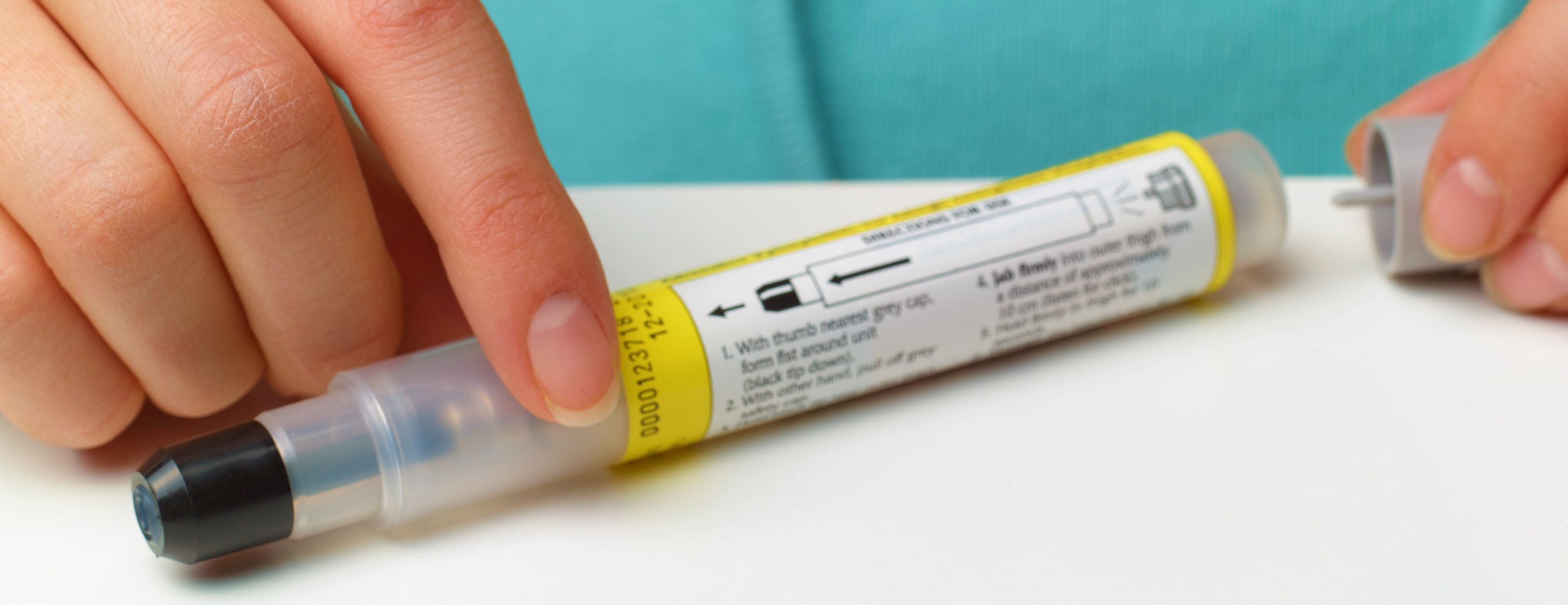Anaphylactic reaction is a serious allergic reaction that is rapid in onset and may cause death. Here is a guide to treating your child’s allergies that may lead to an anaphylactic reaction.
Food Allergens
90 percent of reactivity is associated with 8 foods:- Milk (cow, sheep, and goat)
- Egg
- Wheat
- Soy
- Peanuts (20% of children may “outgrow” allergy)
- Tree nuts (10% may “outgrow”)
- Fish
- Shellfish
Administering Epinephrine
Epinephrine Is the Only Treatment for Anaphylactic Reactions. Treatment fails when epinephrine is not administered promptly.
Things to Keep in Mind; Build a Team
- Please make sure your healthcare provider shows you the right way to use it.
- If you have any questions, ask your healthcare provider.
- You can also ask your pharmacist for a shot trainer to help you and your child practice how an injection will be given. Practicing and discussing the shot with your child before an emergency can help your child be a willing participant.
- Be sure that your shot pack is always with your child.
- Teachers and caregivers should always be confident giving this shot.
Steps to Administering the Shot an Epinephrine Shot
Your child needs to hold still during the injection. If she cannot, have another adult hold your child. If you are alone with your child, lie her down and then lay down across her chest to keep her still. Use one hand to hold a leg and the other hand to give the injection.
- With the injector’s tip facing down, grab it with one hand and make a fist. Do not touch the tip.
- With the other hand, remove the cover from the shot.
- Hold the injector close to your child’s leg and jab the shot forcefully into the thigh. The shot should be given only in the upper leg muscle of the child. The shot can and should be given through clothing.
- Hold the injector in your child’s thigh for 10 seconds. You should see a red flag in the injector window, which indicates that the epinephrine has been given.
- Remove the injector and hold your hand over the injection site, rubbing the area for 10 seconds. Many epinephrine packs come with an antihistamine tablet. Give your child the tablet.
- Put the injector in the storage tube that came in the pack and keep it with you to give to the doctor later.
- Call 911. A shot is not a cure or a complete treatment for an allergic reaction; it simply gives you more time to get your child to the hospital.
- After you have given the shot, there will be liquid remaining in the injector. Do not re-inject your child. It is normal for liquid to remain.
Upkeeping Your Supply of Epinephrine
- The epinephrine shot can be effective only if the medicine is still potent.
- Epi shots do not need to be refrigerated, but they do need to be kept at room temperature and away from direct sunlight.
-
There are three instances when the shot pack should be replaced:
- If the liquid in the injector is no longer clear
- If particles are floating in it
- If the expiration date on the shot pack has passed—but don’t throw it away until you have the replacement.
- The clarity of the liquid is much more important than the expiration date.
Information by the Meredith Corporation.
Symptoms/Signs of an Anaphylatic Reaction |
|||
Skin |
Gut |
||
- Ear canals |
|
||
Mouth |
Heart |
||
- Lips
|
|
||
Nose/Throat |
Neurological |
||
|
|
||
Other |
|||
|
|||
How to Read Labels |
||
Peanut-Free Diet |
||
| Avoid foods that contain peanuts or any of these ingredients: Artificial nuts Beer nuts Cold-pressed, expellerpressed, or extruded peanut oil Goobers Ground nuts |
Mixed nuts Monkey nuts Nut pieces Nut meat Peanut butter Peanut flour Peanut protein hydrolysate |
|
| All FDA-regulated manufactured food products that contain peanuts as an ingredient are required by U.S. law to list the word “peanut” on the product label. | ||
Milk-Free Diet |
||
| Avoid foods that contain milk or any of these ingredients: Butter, butter fat, butter oil, butter acid, butter ester(s), ghee Buttermilk Casein, casein hydrolysate, caseinates Cheese, curds Cottage cheese Cream |
Custard, pudding Diacetyl Half-and-half Lactalbumin, lactalbumin phosphate Lactoferrin Lactose, lactulose Milk in all forms (including condensed, derivative, evaporated, goat’s milk, milk from other animals, lowfat, malted, milkfat, nonfat, powder, protein, skimmed, solids, whole) |
Milk protein hydrolysate Recaldent® Rennet casein Sour cream Tagatose Whey (all forms), whey protein hydrolysate Yogurt |
| All FDA-regulated manufactured food products that contain milk as an ingredient are required by U.S. law to list the word “milk” on the product label. | ||
Egg-Free Diet |
||
| Avoid foods that contain eggs or any of these ingredients: Albumin (also spelled albumen) Egg (dried, powdered, solids, white, yolk) Eggnog |
Lysozyme Mayonnaise Meringue (meringue powder) Ovalbumin Surimi |
|
| All FDA-regulated manufactured food products that contain egg as an ingredient are required by U.S. law to list the word “egg” on the product label. | ||
Soy-Free Diet |
||
| Avoid foods that contain soy or any of these ingredients: Edamame Miso Natto Shoyu Soy (soy albumin, soy cheese, soy fiber, soy flour, soy grits, soy ice cream, soy milk, soy nuts, soy sprouts, soy yogurt) Soya |
Soybean (curd, granules) Soy protein (concentrate, hydrolyzed, isolate) Soy sauce Tamari Tempeh Textured vegetable protein (TVP) Tofu |
|
| All FDA-regulated manufactured food products that contain soy as an ingredient are required by U.S. law to list the word “soy” on the product label. | ||






























